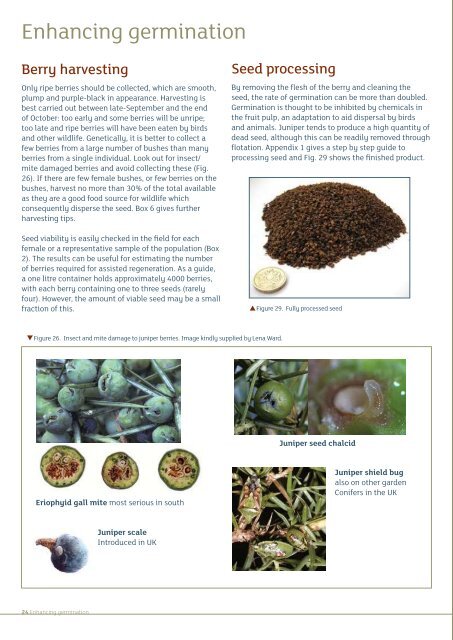Breaking new ground for juniper - Plantlife
Breaking new ground for juniper - Plantlife
Breaking new ground for juniper - Plantlife
- No tags were found...
You also want an ePaper? Increase the reach of your titles
YUMPU automatically turns print PDFs into web optimized ePapers that Google loves.
Enhancing germinationBerry harvestingOnly ripe berries should be collected, which are smooth,plump and purple-black in appearance. Harvesting isbest carried out between late-September and the endof October: too early and some berries will be unripe;too late and ripe berries will have been eaten by birdsand other wildlife. Genetically, it is better to collect afew berries from a large number of bushes than manyberries from a single individual. Look out <strong>for</strong> insect/mite damaged berries and avoid collecting these (Fig.26). If there are few female bushes, or few berries on thebushes, harvest no more than 30% of the total availableas they are a good food source <strong>for</strong> wildlife whichconsequently disperse the seed. Box 6 gives furtherharvesting tips.Seed processingBy removing the flesh of the berry and cleaning theseed, the rate of germination can be more than doubled.Germination is thought to be inhibited by chemicals inthe fruit pulp, an adaptation to aid dispersal by birdsand animals. Juniper tends to produce a high quantity ofdead seed, although this can be readily removed throughflotation. Appendix 1 gives a step by step guide toprocessing seed and Fig. 29 shows the finished product.Box 6. Top tips <strong>for</strong> collecting berriesEquipment / materials: collecting bags or containers, work gloves, eye protection (advisable), ‘berrycatcher’ (e.g. upturned umbrella, bucket, tray or <strong>ground</strong> sheet), GPS, notebook & pen.• Keep a record of each parent bush (GPS grid ref,age class, approximate number of berries taken,by whom); these details can be databased off site• Label containers/bags to cross-reference withwritten record• For large populations, it may be impractical torecord every bush, in which case, keep separatecollections <strong>for</strong> each stand or colony• Collecting berries one at a time is impractical.A good alternative is to brush off berries with agloved hand while holding a container beneath(Figs. 27 & 28, options listed above).Figure 27• Collect from as many different femalesas possible• Ignore sickly looking bushes and those withabundant insect/mite damaged berries• Avoid green or brown berries or those that areblue-black wrinkled• Whilst on site, remove invertebratesand debris from the container- e.g. through winnowing.• Process berries to remove seed as soon as possible(Appendix 1)Figure 28Seed viability is easily checked in the field <strong>for</strong> eachfemale or a representative sample of the population (Box2). The results can be useful <strong>for</strong> estimating the numberof berries required <strong>for</strong> assisted regeneration. As a guide,a one litre container holds approximately 4000 berries,with each berry containing one to three seeds (rarelyfour). However, the amount of viable seed may be a smallfraction of this.Figure 29. Fully processed seedFigure 26. Insect and mite damage to <strong>juniper</strong> berries. Image kindly supplied by Lena Ward.Storing seed and stratificationSowingEriophyid gall mite most serious in southJuniper scaleIntroduced in UKJuniper seed chalcidJuniper shield bugalso on other gardenConifers in the UKJuniper seed can be readily stored without degrading.Ensure the seed is dry (moisture can cause mould),be<strong>for</strong>e putting in a loosely-tied plastic bag and then in adomestic fridge (about +4 o C). Stored in this way, the seeddeteriorates very slowly (over a number of years).Juniper seed is classed as ‘deeply dormant’ becauseit will only germinate after experiencing a series ofseasonal temperature changes. It is possible to shortenthe dormancy period by emulating the seasons.Preliminary results from Forest Research trials suggestthat seed subjected to two weeks of warm temperaturesfollowed by an indefinite cold period triggers the highestgermination rate in just 40 weeks. In the absence ofincubation facilities, similar conditions can be recreatedusing a cellar <strong>for</strong> the warm period and a fridge <strong>for</strong> the cold.Sowing should be undertaken in the autumn be<strong>for</strong>e theonset of winter. Although seed can be sown immediatelyafter processing, without stratification germination willnormally take at least 18 months.The amount to sow will depend on the size of thescrape but also seed availability. As a rule of thumb wesuggest sowing up to 30 viable seed per sq m. Only asmall fraction of this is likely to germinate and survivethe seedling stage. Appendix 1 includes a guide tomeasurement.A record should be kept of the sowing date, the numbersown, and exactly locality (use a GPS). Pass thisin<strong>for</strong>mation to your local biological records centre orthe county botanical recorder (Botanical Society of theBritish Isles), or <strong>Plantlife</strong>.24 Enhancing germination <strong>Breaking</strong> <strong>new</strong> <strong>ground</strong> <strong>for</strong> lowland <strong>juniper</strong> 25
















